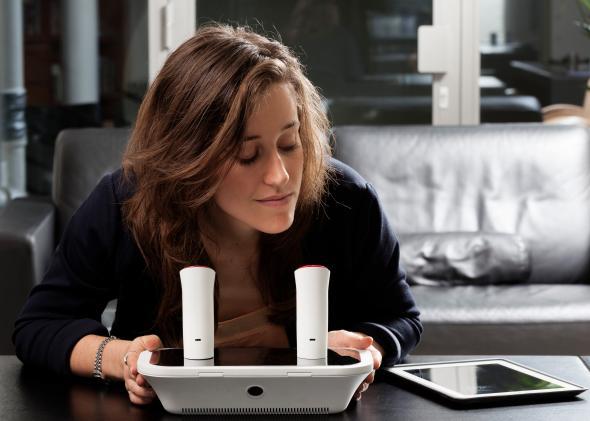Soon the most obsessive brunch documenters of Instagram and Facebook could outdo one another in a new, more pungent manner—the scent text message. Imagine sending a waft of Eggs Benedict via your smartphone.
That particular whiff may soon be possible thanks to the oPhone, a product of Vapor Communications, a company based in Paris and in Cambridge, Mass. The oPhone is part of a smell text messaging system cooked up by Harvard professor David Edwards and his co-inventor and former student, Rachel Field.
On Tuesday, the American Museum of Natural History played host to an oPhone, where Edwards received the first trans-Atlantic scent message—a Champagne-and-chocolate smell-o-gram sent from Paris to New York.
But how does it work? According to Wired, the oPhone DUO, “a kind of telephone for aromas,” features two cylindrical gadgets that deliver bursts of scents for 10 seconds at a time. This is made possible by the oChip, a tiny cartridge that can produce hundreds of odors and that Edwards hopes will one day be installed in your smartphone. The oPhone DUO has eight chips, each containing four aromas. Vapor Communications compares them to ink cartridges—they are capable of diffusing 32 aromas in more than 300,000 different combinations over potentially hundreds of uses. And no need to worry about a bad friend sending you the smell of hot New York trash—the company is concentrating on developing food notes for now. Next up: a coffee palate.
To send your own smell mail, you need to download the free iPhone app, “oSnap,” which allows users to take a photo and tag it as you would tag friends on Facebook, but with the smell of “malty cereal” or “cedar.” You can then send this message (or “oNote” as they call it), via email, Facebook, or Twitter, to be received at oPhone hotspots—for now, just the Manhattan, Paris, and Cambridge, Mass. locations.
Currently, oSnap users have to select the scents for themselves, but Vapor Communications hopes the app will one day be able to detect objects within a picture—say a dense chocolate mud cake—and automatically tag it with the appropriate aroma. To fund the project, the company has launched an Indiegogo campaign. The oPhone should be available to buy in early 2015 at a presale price of $149, and later at $199.
So, do we want to enter a world in which cruel friends dining at Copenhagen’s Noma restaurant send you a photo complete with the smell of rich butter and lobster while you languish at your desk with a stale bagel? That may be too cynical a take. Smell, arguably more than any other sense, can conjure powerful emotions and memories, so maybe it is time for technology to pay a little attention to our olfactory needs.
Perhaps smell has been largely neglected until now because, as Piet Vroon pointed out in his book Smell: The Secret Seducer, odors cannot be easily identified or quantified. “Scents and associated olfactory sensations are not nearly as easy to measure or map as stimuli and observations based on light and sound: after all, a scent has no wavelength or other easily measurable property,” he wrote. While some fairly rudimentary gadgets let off scents—Febreze, anyone?—this sheer messiness has kept most technologists and inventors away from the more redolent world, until now. After all, everyone knows the scent of new smartphones and tablets is the dull notes of metal and plastic, with a hint of anxiety.
Smell, “as the sense of lust, desire and impulse it carries the stamp of animality,” Vroon quotes. In comparison, despite a preponderance of emoticons, simple texting and emailing seems clinical and unromantic. Scent-delivering smartphones might inject a little passion and whimsy into the communications of anyone with a nose, giving us a fuller picture of what others are experiencing. As long as the snap-happy brunchers don’t take over.
